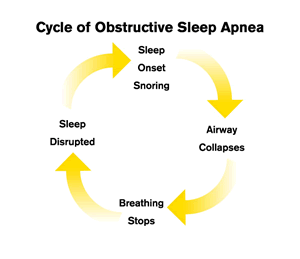

The Continuous Positive Airway Pressure machine consists of the following:
- Mask to cover nose and mouth.
- Another mask that only covers the nose (Nasal Continuous Positive Airway Pressure).
- Nose Prongs.
- Motor machine to blow air.
- Tube to connect the mask and motor machine.
CPAP treatment is a nonsurgical method of treating sleep apnea which comes as a mask that is worn on the nose or mask. This mask is connected to a pump that mildly pumps positive air pressure into the nasal passages so as to keep them open. It is important for sleep tests to be performed on your before Continuous Positive Airway Pressure is recommended. Most insurance companies nowadays pay for both the tests and CPAP treatment.
CPAP: How it Works
In Obstructive Sleep Apnea, muscles at the back of the throat collapse causing the uvula and other tissues to relax and restrict the flow of air. Continuous Positive Airway Pressure treats sleep apnea symptoms by delivering continuously pumping air into the nasal passages.
This way, the collapsing muscles, and tissues are kept in position and therefore do not restrict airflow. The brief stops in breathing (apneas) are minimized. The CPAP mask is work at before sleep and removed in the morning.
Studies have shown that since patients using CPAP sleep more comfortably, the experience fewer episodes of daytime sleepiness. Sleep apnea is known to increase blood pressure. Continuous Positive Airway Pressure is successful at reducing blood pressure during the day and also at night. Patients using Continuous Positive Airway Pressure are less likely to suffer from heart diseases.
CPAP: Side Effects
- Lead to increased cases of dreaming and nightmares.
- Some patients experience a dry and running nose.
- Nasal congestion and congestion.
- Allergic reaction in the eyes or skin.
- Headaches and abdominal bloating.
- Nose bleeding though this is a rare side effect.
Most of the side effects usually disappear within the first few weeks of using CPAP. New users have to cope with having to breathe out against the pressure. Breathing out is especially difficult before you achieve sleep. Here the Ramp function of the CPAP machine can be used to start the machine slowly then increase the pressure as you sleep.
BiPAP machines can be used to help you to breathe out more comfortably. Unlike CPAP which only pumps air in one way, BiPAP assists you to breathe out too. BiPAP can be set to match your rate of inhalation and exhalation. Side effect as a result of CPAP can also be relieved through:
- Seeking professional help in adjusting the mask.
- Always wear the mask or nasal prong properly.
- Nasal irritation can be reduced using a humidifier or nasal spray.
- Consulting regularly with your doctor.
CPAP machines are expensive and therefore you want sleep studies to be done on you before the machine is bought. It is advisable to rent the device before you finally settle on the ideal one to buy. You are advised to use the machine everyday even if the symptoms reduce.
